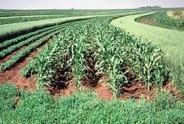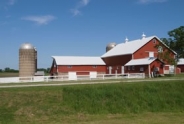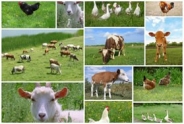Fall Lime Application
Katelyn Miller, Field Crops and Forage Specialist
Southwest New York Dairy, Livestock and Field Crops Program
Why apply lime in the fall?
A large benefit of applying lime in the fall is time. When spring rolls around, farmers are busy catching up. Between working fields, planting crops, harvesting 1st cutting, etcetera, time becomes scarce. When wet springs occur, getting everything done becomes even more of a challenge. Applying lime during a wet season can increase risk of compaction, creating the possible chance of more passes being necessary with tillage implements. With highly erodible fields, be cautious of your timing in relation to precipitation to ensure you're getting the most out of your lime. Another benefit is increased reaction time in the soil. A good rule of thumb is to apply lime 6 months before the desired pH for your crop is needed, therefore, applying lime in the fall creates ample time for your desired pH to occur.
Why is lime important?
Lime increases the pH of the soil, making it an important part of crop management. The pH level in your soil has an impact on nutrient availability in plants (see picture), nitrogen fixation in legumes, plant health and root growth. Crops have different required pH levels (see chart) making proper management essential to a strong crop. Inadequate pH will create a weaker crop because of poor growth, in turn reducing water intake, and make nutrients less available to the plant, creating possible deficiencies. To help avoid these problems, it is recommended to soil test approximately every three years to ensure that pH levels are appropriate for the crop you are growing.
How does tillage system impact lime results?
In a conventional tillage system, lime will get incorporated into the soil causing it to react faster. This is not the case with no-till, where pH needs to be closely monitored for changes because lime is only being applied to the surface. Due to this, there can also be pH differences among soil layers making close management key to a successful liming program.
Additional resources are available here:
Soil pH for Field Crops: Cornell University Nutrient Management Spear Program
http://nmsp.cals.cornell.edu/N...
Timing of Lime Application for Field Crops: Cornell University Nutrient Management Spear Program
http://nmsp.cals.cornell.edu/p...
Winter Limestone Application: Penn State Extension
https://extension.psu.edu/wint...
Upcoming Events
Crops, Cows & Critters - Southwest New York Dairy, Livestock & Field Crops Newsletter Sponsorship
December 19, 2025
Our two forms of publications feature research-based and timely information from our four specialists, listed to the right, along with local event notifications and Cornell University outreach. This information is provided to participants who range from dairy, livestock, and field crops producers to agricultural suppliers and consultants.
Weekly Email Update: Shared with 625+ households who have signed up with our program.
Monthly Paper Mailer: To reach our stakeholders and farmers who lack internet access, we send out a monthly mailer where your company's logo and contact information would be featured with a mailing list of 330+ households.
If you sponsor our weekly and monthly publications you reach approximately 955 households.
Visit our website to view our newsletters!
2025 Cornell Food Beverage & Animal Feed Manufacturer Survey
December 19, 2025
Industry and Educational Advocates for New York State's Food, Beverage, and Animal Feed Manufacturing industries:
As you know, NYS has a diverse food and beverage manufacturing industry, in both the types of industries that exist and the wide distribution of firms by scale. Many manufacturing firms have strong backward linkages to agricultural production sectors in the state that support both farm-level and downstream food industry firms and consumers. In collaboration with the New York State Department of Agriculture and Markets, a team from Cornell University's Charles H. Dyson School of Applied Economics and Management has recently rolled out the 2025 New York State Food, Beverage, and Animal Feed Manufacturer Survey. The industry will benefit from an updated assessment of the industry that informs private and public investments and opportunities to support firm growth and improved profitability.
Boots in the Barn: Cornell Dairy Research Updates
January 13, 2026
January 20, 2026
January 27, 2026
February 3, 2026
February 10, 2026
February 17, 2026
February 24, 2026
Join us for some or all!
Announcements
No announcements at this time.





